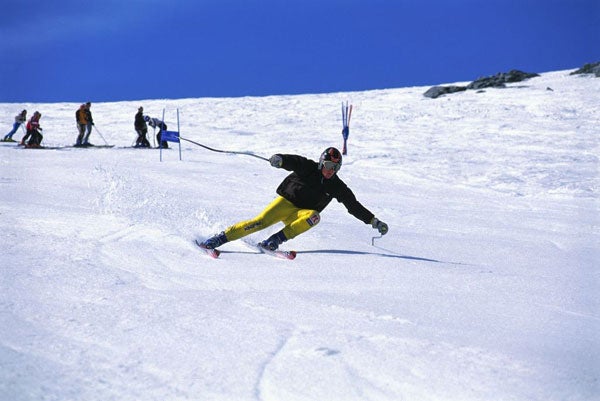Simon Calder: Skiers with latitude should leave it late
The man who pays his way

Curiously, given that it is springtime, an autumnal melancholy is afflicting certain parts of Europe this week – though nothing to do with volcanic ash dulling the view. The locations are linked, anagrammatically at least: they are either high altitude or high latitude. They are winter-sports resorts, who find themselves at that very tricky point in the year when the "winter" component of their offering is visibly melting away due to the inconvenient warming that seems to happen annually in this hemisphere.
Given the seasonal nature of skiing, it is natural that resorts should seek to extend their brief window of commercial opportunity until the sun lays bare the naked and, often, ugly truth about what lies concealed beneath the forgiving, frosty duvet. The marketing process is uncomfortable and not very rewarding – rather like that over-ambitious last run of the afternoon, through slush with the consistency of porridge.
The weary souls whose job it is to squeeze the last few marginal bucks from the final week of a ski season try a range of tricks. The Trois Vallées in the French Alps has slashed its rates for lift passes beginning today; a family of four can ski anywhere in the world's biggest ski area all week for under €600. Other locations simply call in the Brits. As a race, we have proved time and again that we never let inappropriate climate stand between us and a bargain. Mad dogs and Englishmen (along with a good few Scots and Welsh) are quite prepared to queue in the noonday sun on the hottest July day at Walt Disney World in Orlando. They are unlikely to find themselves jostling with Americans, since the average sane US citizen knows that central Florida is a winter destination.
Accordingly, in Norway's leading ski resort, Trysil, the usually predominant Danish, Swedish and German accents have been supplanted by British voices. I know this because I am one of the bargain seekers who spotted the opportunity provided by relatively cheap flights to Oslo combined with end-of-season hotel rates to grab a last-gasp skiing holiday (given that I am writing this with a couple of days still to ski, and am so far orthopaedically intact, I shall not tempt fate by calling it a "short break").
Up here at 1,100m (yes, barely above England's and Wales' highest points) your grasp of Norwegian need not be as solid as ice to work out that stengt means "closed"; the word appears on one of the chairlifts, for which the season ended on Sunday, and on a big red sign at the top of some of the runs. What Trysil lacks in altitude, though, it makes up for in latitude: 62 degrees north places it nearer the pole than Anchorage in Alaska, Shetland and St Petersburg. So skiing on the north-facing slopes is still feasible in May, though most tourists will melt away this weekend – in the case of many UK visitors, with severe bruising in the wallet area. Further complications are likely to set in once the credit-card bill arrives. This latter complaint can be avoided by locking in to a fixed rate of exchange and buying currency in advance.
After an hour spent in the UK's highest concentration of bureaux de change, the Bayswater area of west London, I found that the Norwegian krone constitutes an "exotic currency" – both in the gaping spread between buying and selling rates, and in the paucity of places that have any on offer. In the closest I shall ever get to breaking the bank, I cleaned out two bureaux de change of their entire holdings of kroner for a total cost of £330.
The overall rate was around nine to the pound, only 10 per cent worse than three years ago. So I now know the price of everything – and, I hope, still appreciate the value of exchanging potential energy for kinetic energy on a spring day in Norway.
A lonely life on Norway's slopes
For most of the winter the most useful attribute of a hotel room in a Norwegian ski resort is a kettle, to provide plenty of warming drinks at minimal cost; but in mid-April the key feature is a pair of heavy curtains to keep out the sun, which would otherwise flood in from 6am and stay until 9pm.
A good problem to have – especially in comparison with early January, when there are barely six hours of daylight and the temperature regularly dropped to minus 20C. If the wind picked up, the stengt ("closed") signs sometimes appeared on the chairlifts: not due to any mechanical danger, but because if the lift paused then the skiers left dangling could start to freeze.
Skiing so far north, so late in the season, brings other issues: at 9.30am on Tuesday morning I reached the foot of one of the main runs and turned to face uphill and take a few photographs of other skiers. There were none.
Subscribe to Independent Premium to bookmark this article
Want to bookmark your favourite articles and stories to read or reference later? Start your Independent Premium subscription today.

Join our commenting forum
Join thought-provoking conversations, follow other Independent readers and see their replies